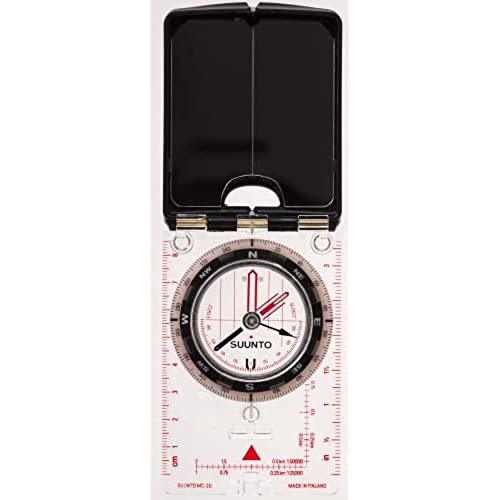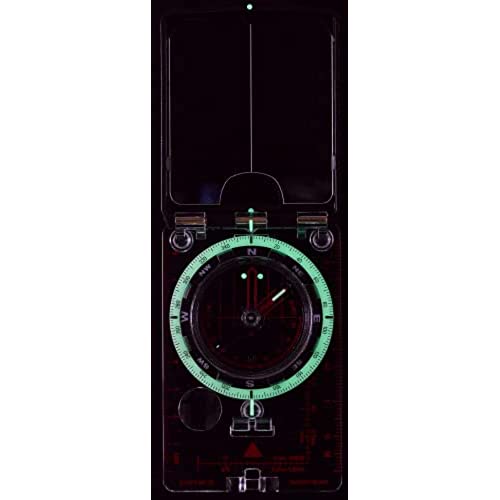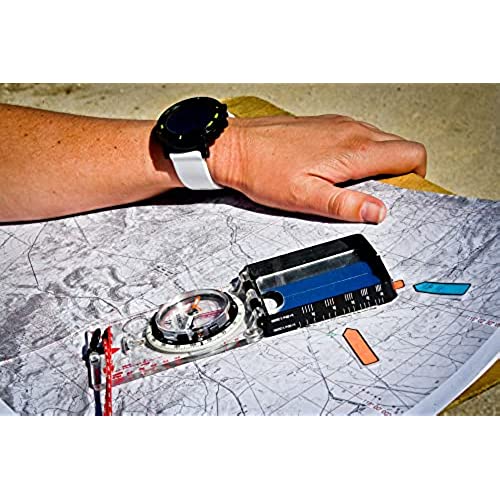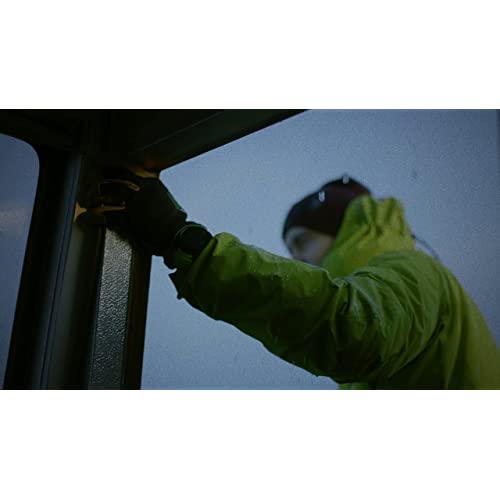













SUUNTO MC-2 Compass: Top-of-the-line compass for professionals & serious hikers
-

Whispers
> 3 dayGood compass but $90 for hard plastic you better invest in a hard case or something to protect it.
-

Estefania Weber
> 3 dayI almost returned this. Seemed totally useless for sighting landmarks on a bearing the first day I tried it. All it took was practice. Great product.
-

Terri
> 3 dayTo take an accurate reading of a distant object, you cant just turn toward the object and look at the needle off-set because the needle isnt very close to the degree marks. You have to turn the bezel to guess the degree radial, then line up the magnetic needle to the red outline on the bezel. If it doesnt line up, you adjust the bezel, sight it in, adjust the bezel, signt it in and repeat until the needle lines up with the red outline WHILE you have the object signted in. Then you can look at the top bezel pointer to see the radial that the distant object is from you. Its a direct radial reading that is VERY accurate. This is different from a military style lensatic compas, where you sight in a distant object then look at what mark the needle is pointed to. Its a faster reading but less acurate - I wouild say +/- 1.5 degrees. When reading a map and moving to a grid location, this compass is perfect. The mirror has a protective layer that took me 10 minutes to realize. I thought it was just a cheap crappy mirror. It is not. There is an optional break-away lanyard attachment that I couldnt figure out. I looped the lanyard in the hole of the compass and sat there with this little black thing, wondering what it was. I had to you-tube it because there are no instructions. Im happy with this purchase and will make the switch from the Military style compass to this useful tool.
-

Bdmagee
> 3 dayFollow-up 1/16/23: replacement is perfect with super fast service. Sometimes life is good This is a great compass however right out of the box there was a 3/4 inch bubble, pretty large by any compass standard, and thats why the 2 stars. Ive ordered a replacement which should arrive tomorrow,1/15/22, then Ill follow up with new review. BTW, for those who are wondering, I live at sea level and it was at room temperature overnight with no change. Let me add, extremely fast delivery and instant customer service. Big 5 stars for that.
-

bikefaster
Greater than one weekI bought a USGS Northern Hemisphere (NH) version a couple years ago and loved it so much I recently decided to buy another one, but chose the Global version this time. I did NOT like the Global version at all, because the needle got stuck, requiring me to repeatedly shake or tip the compass to get the needle to unstick and point north. With some research, I found that others have had the same problem. The needle on the global version has little vertical feet at both ends, where the clear plastic is bent up at 90 degrees, and these drag on the top side of the capsule a bit. Also, the black (south) end of the needle is much higher than the red (north) end. The whole needle is tilted down toward the red end. I returned the global version and got another norther hemisphere version and the NH version needle is very smooth and doesnt stick at all. I highly recommend the NH version, it is excellent. If I travel to the Southern Hemisphere I will get a dedicated SH compass rather than the global version.
-

Aces
> 3 dayI was looking for another quality hiking Compass, similar to my circa 1972 Silva Ranger. The hunt to find its equal was difficult, but lead me here; to the Suunto MC-2/LIN Compass. To begin with, let me say I am VERY pleased with it. It has the features and Quality that I was looking for. Its just that even when I ordered it, I was uncertain exactly which variation of the Suunto Line, I was getting. What this actually is, is a Suunto MC-2/360/IN/D/L/NH, also known as p/n: SS004239001. Heres the breakdown of the features: -Baseplate Compass with sighting Mirror -360° graduations on the dial -Ruler on base is in Inches, but includes scales in Miles for 1:24,000 and 1:625,000 scale maps -Has adjustable Declination Setting. comes with tool to adjust this. -Has Luminous Dial & Sighting Points. -Has 2-Zone needle, designed to work anywhere in the Northern Hemisphere. -Has Magnifier built into the baseplate. -Has Inclinometer needle to to measure angles of Elevation -Comes with Lanyard thats both detachable and has wrist loop adjustment feature. You have to admit thats a lot of good features for the price. (I got mine for just under $40). So how well does it do all these things? Amazingly well. The declination tool is Stainless Steel, so its both Strong and yet it wont affect the magnetic needle on the compass. If you arent familiar with Declination adjustment, Google/Bing declination calculator, and you should find the noaa.gov website that will tell you what to set the compass too (pay attention to if its East or West!). Youll find that if you only travel a few hundred miles in any direction, the declination should be within 2° what you set it too. The needle balance is great here at the North edge of the US. And it turns freely even when off of level slightly. The dial turns freely, but not so much that Id worry about bumping it off from my setting. And the cut-out in the sighting mirror makes it easier to sight on something at the same elevation as you. The Lanyard has a large plastic piece that if you squeeze it, you can slide it, making the loop near the compass smaller or larger. I think its so you can keep it from coming off your wrist. I use it on my neck, so its not that important to me. The Magnifying Patch is about 0.5 diameter, and is very nice. I can imagine using it on fine print on maps or even to see a splinter in a finger. So what didnt I like about it? The luminous points seem to dim very fast once you turn off whatever light source you are using to illuminate them. And I used a 300 Lumen flashlight to do this. But thats pretty much standard for anything thats not Tritium (I dont know of any compasses that have Tritium). The Inclinometer is nice to have. But the graduations are too small for me to read through the mirror, unless I have a piece of white paper behind the base of the compass, and the lighting is really good. And sometimes the magnetic needle hangs in the way of the indicator. Its important to set the compass to 270° True, when doing an inclinometer reading. Dont expect to measure angles of Elevation better than +/- 2°. The clasp to swing the Mirror open is very tight. you might have trouble opening it with wool gloves on. But perhaps my single biggest gripe with this compass is the joke of an instruction manual that comes with it. Here you have some outstanding features on this device. But unless you have a lot of experience with other quality instruments, you wont even know what its capable of. And yes, I am picky about such things. I spent several years involved in Search and Rescue as a teenager. Ive Orienteered a few times. And Ive been Hiking for over 40 years. So if you get a good quality compass like this, invest in a good book on using it. Or attend a clinic on compass use. Stay safe out there...
-

Mr. Z
> 3 dayIt seems like a good compass however I received a different configuration that is not with a glow in the dark dial (as shown in all pictures of the product description). The one I received is a lower price version too... based on other reviews this is not the first time this has happened.
